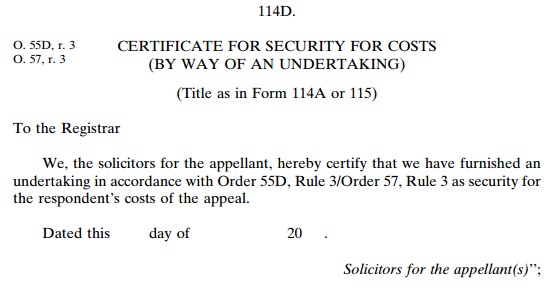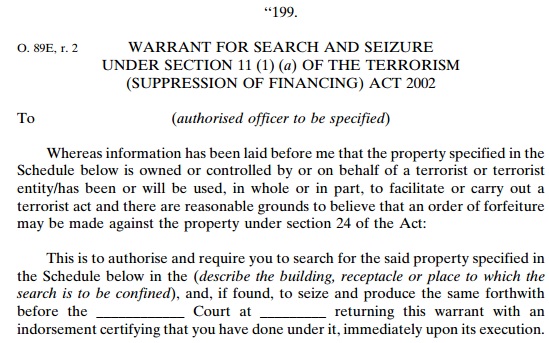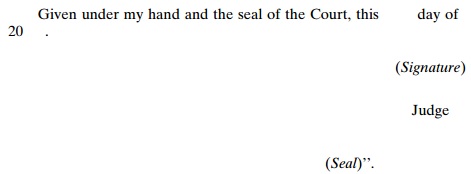9. The principal Rules are amended by inserting, immediately after Order 89D, the following Order:“ | TERRORISM (SUPPRESSION OF
FINANCING) ACT 2002 |
|
|
| Interpretation and application (O. 89E, r. 1) |
1.—(1) In this Order, “Act” means the Terrorism (Suppression of Financing) Act 2002 (Act 16 of 2002) and any reference to a section shall, unless it is otherwise expressly provided, be construed as a reference to a section in the Act.| (2) Expressions used in this Order which are used in the Act have the same meanings in this Order as in the Act. |
| (3) An application to which this Order applies must, where an action is pending, be made by summons in the action, and in any other case by originating summons to which appearance is not required. |
| (4) This Order is not applicable to the Subordinate Courts. |
|
| Application for warrant for search and seizure or restraint order (O. 89E, r. 2) |
2.—(1) An application for —| (a) | a warrant for search and seizure under section 11(1)(a); or | | (b) | a restraint order under section 11(1)(b), |
| must be made by ex parte summons. |
| (2) An application under paragraph (1) shall be entitled in the matter of the owner or person who has control of the property, if known, naming him as the respondent, and in the matter of the Act, and all subsequent documents in the matter shall be so entitled. |
(3) An application under paragraph (1)(a) must be supported by an affidavit which must —| (a) | state the grounds for believing that the property in respect of which the warrant is sought —| (i) | is owned or controlled by or on behalf of a terrorist or terrorist entity; or | | (ii) | has been or will be used, in whole or in part, to facilitate or carry out a terrorist act; and |
| | (b) | state the full particulars and the location of the property in respect of which the warrant is sought and specify the person or persons in possession of such property, as the deponent is, to the best of his knowledge, able to provide. |
|
(4) An application under paragraph (1)(b) must be supported by an affidavit which must —| (a) | state the grounds for believing that the property in respect of which the restraint order is sought —| (i) | is owned or controlled by the respondent, who is a terrorist or terrorist entity or who is acting on behalf of any terrorist or terrorist entity; or | | (ii) | has been or will be used, in whole or in part, to facilitate or carry out a terrorist act; and |
| | (b) | state whether the property in respect of which the restraint order is sought is believed to be situated in or outside Singapore. |
|
| (5) A warrant for search and seizure shall be in Form 199. |
(6) Where a restraint order is issued under section 11(1)(b), the Attorney-General must —| (a) | unless the Court otherwise provides, serve copies of the order and the affidavit in support of the summons therefor on the respondent and, where property to which the order relates is held by another person, on that person; and | | (b) | serve a copy of the order on all other persons affected by the order. |
|
|
| Application by Attorney-General to revoke or vary warrant or order (O. 89E, r. 3) |
3.—(1) An application by the Attorney-General under section 18 to revoke or vary a warrant or an order made under Part IV of the Act must be made by summons.(2) An application under paragraph (1) to revoke or vary a warrant issued under section 11(1)(a) or an order issued under section 11(1)(b) and an affidavit in support thereof must be filed and served on —| (a) | any person having any interest in the property to which the application relates; and | | (b) | any person appointed under section 15 (1), |
| within 7 days after the date of filing of the application. |
|
|
| Application by interested person to revoke or vary warrant for search and seizure or restraint order or for examination of property (O. 89E, r. 4) |
4.—(1) An application under section 19(1) by any person who has an interest in the property that was seized under a warrant of search and seizure under section 11(1)(a) or in respect of which a restraint order was issued under section 11(1)(b) —| (a) | for an order under section 19(4); or | | (b) | for permission to examine the property, |
(2) An application under paragraph (1)(a) or (b) must be filed and served with an affidavit in support thereof on —| (a) | the Attorney-General; | | (b) | any other person having an interest in the property to which the application relates; and | | (c) | any person appointed under section 15 (1), |
| not less than 2 clear days before the date fixed for the hearing of the summons. |
|
|
| Application for continuation of warrant for search and seizure or restraint order (O. 89E, r. 5) |
5.—(1) An application by the Attorney-General under section 20(3) for the continuation of a warrant for search and seizure or restraint order issued under section 11 must be made by summons.| (2) An application under paragraph (1) must be supported by an affidavit which must state the basis for the continuation of the warrant for search and seizure or restraint order. |
| (3) The application and the affidavit referred to in paragraph (2) must be filed and served on any person having any interest in the property to which the application relates within 7 days after the date of filing of the application. |
|
| Application for appointment of manager (O. 89E, r. 6) |
6.—(1) Subject to paragraph (2), Order 30, Rules 2 to 6, shall apply where the Public Trustee is appointed under section 15.| (2) It shall not be necessary for an affidavit of fitness to be sworn or for the Public Trustee to give security. |
|
| Application for order to destroy property (O. 89E, r. 7) |
7.—(1) An application by a person appointed under section 15 for a destruction order under section 16 (2) must be made by summons.(2) An application under paragraph (1) must be supported by an affidavit which must —| (a) | state the full particulars of the property to be destroyed; and | | (b) | state the reasons for destroying the property. |
|
(3) An application under paragraph (1) and the affidavit in support thereof must be filed and served on —| (a) | the Attorney-General; and | | (b) | any person having a valid interest in the property to be destroyed, |
| within 7 days after the date of filing of the application. |
|
|
| Application for order of forfeiture (O. 89E, r. 8) |
8.—(1) An application for an order of forfeiture under section 21 must be made by summons.| (2) An application under paragraph (1) shall be entitled in the matter of the owner or person who has control of the property, if known, naming him as the respondent, and in the matter of the Act, and all subsequent documents in the matter shall be so entitled. |
(3) An application under paragraph (1) must be supported by an affidavit which must —| (a) | state the grounds for believing that —| (i) | the property is owned or controlled by or on behalf of a terrorist or terrorist entity; or | | (ii) | the property has been or will be used, in whole or in part, to facilitate or carry out a terrorist act; |
| | (b) | state the full particulars of the property in respect of which the order is sought and specify the person or persons in possession of such property; and | | (c) | state whether a warrant for search and seizure or restraint order has been issued under section 11(1) in relation to the property. |
|
(4) An application under paragraph (1) and the affidavit in support thereof must be filed and served on —| (a) | the respondent; | | (b) | any person having an interest in the property to be forfeited; and | | (c) | any person appointed under section 15(1), |
| within 7 days after the date of filing of the application. |
|
|
| Application to set aside or vary forfeiture orders (O. 89E, r. 9) |
9.—(1) An application under section 27(1) to vary or set aside a forfeiture order must be made by summons.(2) An application under paragraph (1) and an affidavit in support thereof must be filed and served on —| (a) | the Attorney-General; and | | (b) | any person appointed under section 15(1), |
| within 7 days after the date of filing of the application. |
|
|
| Confidentiality of documents (O. 89E, r. 10) |
| 10. Notwithstanding Order 60, Rule 4, no person may inspect or take a copy of any document filed under this Order without the leave of a Judge.”. |
|
|




